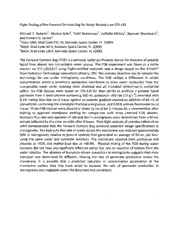
NASA Technical Reports Server (NTRS) 20110016175: Flight Testing of the Forward Osmosis Bag for Water Recovery on STS-135 PDF
Preview NASA Technical Reports Server (NTRS) 20110016175: Flight Testing of the Forward Osmosis Bag for Water Recovery on STS-135
Flight Testing ofthe Forward Osmosis Bag for Water Recoveryon STS-135 Michael S. Roberts1, Monica Soler\ Todd Mortenson1, LaShelle McCol, Spencer Woodward2, 3 and Howard G. Levine lTeam QNA, Mail Code ESC-24, Kennedy Space Center, FL 32899 2NASA, Mail Code NE-S, Kennedy Space Center, FL 32899 3NASA, Mail Code UB-R, Kennedy Space Center, FL 32899 The Forward Osmosis Bag (FOB) is a personal water purification device for recovery of potable liquid from almost any non-potable water source. The FOB experiment was flown as a sortie mission on STS-135/ULF7 using flight-certified materials and a design based on the X-Pack™ from Hydration Technology Innovations (Albany, OR). The primary objective was to validate the technology for use under microgravity conditions. The FOB utilizes a difference in solute concentration across a selectively permeable membrane to draw water molecules from the non-potable water while rejecting most chemical and all microbial contaminants contained within. Six FOB devices were tested on STS-135 for their ability to produce a potable liquid permeate from a feed solution containing 500 mL potassium chloride (15 g L-1) amended with 0.1% methyl blue dye (w:v) tracer against an osmotic gradient created by addition of 60 mL of concentrate containing the osmolytes fructose and glucose, and 0.01% sodium fluorescein (w:v) tracer. Three FOB devices were physically mixed by hand for 2 minutes by acrewmember after loading to augment membrane wetting for comparison with three unmixed FOB devices. Hydraulic flux rate and rejection ofsalt and dye in microgravity were determined from a60-mL sample collected bythe crew on orbit after 6 hours. Post-flight analysis ofsamples collected on orbit demonstrated that the Forward Osmosis Bag achieved expected design specifications in microgravity. The hydraulic flux rate ofwater across the membrane was reduced approximately 50% in microgravity relative to ground controls that generated an average of 50 mL per hour using the same water and osmolyte solutions. The membrane rejected both potassium and chloride at >92% and methyl blue dye at >99.9%. Physical mixing of the FOB during water recovery did not have any significant effect on either flux rate or rejection of solutes from the water solution. The absence of buoyancy-driven convection in microgravity suggests that mass transport was dominated by diffusion, slowing the rate of permeate production across the membrane. It is possible that a predicted reduction in concentration polarization at the membrane surface that may have acted to increase the rate of permeate production in microgravitywas negligible underthe described test conditions.
